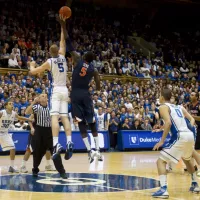Women's basketball, a team sport derived from men's basketball, originated in 1892 at Smith College. It quickly gained popularity throughout the United States, particularly in women's college competitions, and has expanded globally. By 2020, it had become one of the world's most popular and rapidly growing sports.
1900: College Enrollment for Women
In 1900 only 2.8% of American women were enrolled in college, and 36% of college graduates were women.
1908: Baer publishes revised rules
In 1908 Clara Gregory Baer published the Newcomb College Basketball Rules.
1936: Founding of the All American Red Heads
In 1936, the first professional women's basketball team, the All American Red Heads, was founded by C. M. "Ole" Olson.
1953: First FIBA Women's World Championship Tournament
Since 1953, FIBA has hosted a world championship tournament for women.
1954: NBA Shot Clock Introduction
Since the shot clock was first introduced in the NBA in 1954, WNBA shot clock was changed from 30 to 24 seconds.
1970: Netball Differentiation
Until 1970, the term "women's basketball" was also used to refer to netball, a women's-only sport derived from basketball.
1971: Title IX Impact on Collegiate Sports
In 1971, Title IX began to significantly impact female collegiate sports, leading to an increase in sports participation among college women.
1971: Adoption of Five-Player, Full Court Game
In 1971, the five-player, full court game was adopted.
1972: Passage of Title IX
In 1972, Title IX was passed to end sexual discrimination and stereotyping in college admissions and academic subjects.
1974: Title IX Regulations Issued
In 1974, the Department of Health, Education, and Welfare issued Title IX regulations regarding intercollegiate athletics.
1974: Formation of Women's Sports Foundation
In 1974, the Women's Sports Foundation was formed.
1976: Women's Basketball at the Olympics
In 1976, women's basketball was added as an official sport of the Olympic Games.
1978: Founding of the Women's Basketball League
In 1978, America's first professional basketball league for women was founded as the Women's Basketball League (WBL).
1978: Application of Title IX
In 1978, colleges and universities were forced to apply Title IX's rules and regulations, adhering to one of three requirements: the proportionality rule, the gender equity rule, or the historical progress rule.
1979: First Nationally Televised Championship Game
In 1979, the first nationally televised championship game occurred with Old Dominion University defeating Louisiana Tech University. The Women's Final Four has been televised as an annual event ever since.
1981: WBL Collapse
In 1981, the Women's Basketball League (WBL) collapsed due to financial issues, poor marketing, and the cancellation of America's participation in the 1980 Summer Olympic Games.
1981: Founding of the Women's National Basketball League (WNBL)
In 1981, the Women's National Basketball League (WNBL) was founded in Australia.
1981: End of the Women's Pro Basketball League
In the spring of 1981, the Women's Pro Basketball League (WPBL) played its third and final season before folding.
1982: NCAA Sponsorship of Women's Basketball
In 1982, the National Collegiate Athletic Association (NCAA) began to sponsor women's basketball.
1984: Introduction of Smaller Ball for NCAA Play
In the fall of 1984, a smaller basketball was introduced for NCAA women's basketball play.
1985: Men's NCAA shot clock introduced
In 1985, a 45-second shot clock was introduced to men's NCAA College basketball.
1993: Men's NCAA shot clock adjustment
In 1993, the men's NCAA shot clock was lowered to 35 seconds.
1993: Creation of the Women's Basketball Association (WBA)
In the summer of 1993, the Women's Basketball Association (WBA) was created in the United States as the second women's professional league.
1995: The WBA's Third Season
In the summer of 1995, the WBA played its third season.
April 1996: WNBA Officially Approved
In April 1996, the NBA Board of Governors officially approved the creation of the WNBA, which was announced at a press conference with Rebecca Lobo, Lisa Leslie, and Sheryl Swoopes.
1996: Founding of the WNBA
In 1996, after several failed attempts at women's professional leagues in the U.S., the NBA founded the WNBA.
1996: Success of the USA Women's National Team
In 1996, the USA women's national team achieved a much-publicized gold medal run at the Summer Olympic Games.
1996: WNBA's Values of Diversity and Inclusion
Since the birth of the WNBA in 1996, the league has emphasized diversity and inclusion, empowering athletes to advocate for what is right for the league and society.
June 1997: WNBA's Inaugural Season
On June 21, 1997, the WNBA began its first season with eight teams, featuring a game between the New York Liberty and the Los Angeles Sparks, televised on NBC.
1997: The WBA Disbands
In 1997, despite plans to play as a 12-team league, the WBA disbanded before the season after FOX Sports purchased Liberty Sports and the WBA.
1997: ABL's Second Season
In 1997, the American Basketball League (ABL) played its second full season.
1997: Inaugural Season of the WNBA
In 1997, the Houston Comets won the inaugural WNBA championship and continued to win for four consecutive years.
December 1998: Folding of the American Basketball League (ABL)
On December 22, 1998, the American Basketball League (ABL) folded during its third season.
1998: Houston Comets Win Championship
In 1998, the Houston Comets won their second consecutive WNBA championship.
1999: Houston Comets Win Championship
In 1999, the Houston Comets won their third consecutive WNBA championship.
2000: Increased Sports Participation Among College Women
By 2000, Title IX had helped increase sports participation among college women by 372 percent, from 32,000 to over 150,000 women.
2000: Houston Comets Win Championship
In 2000, the Houston Comets won their fourth consecutive WNBA championship.
2000: FIBA shot clock change
Since 2000, the WNBA shot clock was changed from 30 to 24 seconds, which has been in FIBA play.
2001: Consequences for Title IX Violations
In 2001, schools face the consequence of losing federal funding for any violation of Title IX.
2001: Start of LGBTQ Community Celebrations
In 2001, the Los Angeles Sparks became the first professional sports team to acknowledge and celebrate Pride Month, starting a trend in the sporting community to support the LGBTQ community.
2001: Los Angeles Sparks Win Championship
In 2001, the Los Angeles Sparks won their first WNBA championship.
2002: Los Angeles Sparks Win Championship
In 2002, the Los Angeles Sparks won their second WNBA championship.
2002: Establishment of the WCBA
In 2002, the Women's Chinese Basketball Association (WCBA) was established.
2003: Tulsa Shock Win Championship
In 2003, the Tulsa Shock won a WNBA championship.
2004: All-Star Game Hiatus in Olympic Years
From 2004 to 2020, the WNBA did not hold an All-Star Game in Olympic years to allow players to participate in the Olympics.
2005: Sacramento Monarchs Win Championship
In 2005, the Sacramento Monarchs won their first and only WNBA championship.
2006: New Teams in Division 2
In 2006, several new teams joined the second division, including the SevenOaks Suns, Enfield Phoenix, Taunton Tigers, and Bristol Storm.
2006: Tulsa Shock Win Championship
In 2006, the Tulsa Shock won another WNBA championship.
2006: Women's Basketball at the Commonwealth Games
In 2006, women's basketball made its first appearance at the Commonwealth Games.
2007: Phoenix Mercury Win Championship
In 2007, the Phoenix Mercury won their first WNBA championship.
2008: Standardization of Women's Basketball Size
As of 2008, the 28.5-inch (72.4 cm) circumference ball, a standard size 6, is used for all senior-level women's competitions worldwide.
2008: Title IX View
In 2008, Title IX is generally viewed as having fixed the problem of gender inequality of sports, at least in educational settings.
2008: Visibility of Women's College Basketball
In 2008, it was noted that the growing visibility of women's college basketball, particularly the NCAA March Madness tournament, was a result of Title IX.
2008: Proportionality Rule and Gender Equity
In 2008, research highlighted the proportionality rule, stating schools should provide athletic opportunities proportional to enrollment. Gender equity requires schools to meet the interests of underrepresented genders, and historical progress dictates efforts to create more opportunities if proportionality isn't met.
2008: Tulsa Shock Win Championship
In 2008, the Tulsa Shock won their third WNBA championship before relocating to Dallas–Fort Worth.
2009: Phoenix Mercury Win Championship
In 2009, the Phoenix Mercury won their second WNBA championship.
2011: Minnesota Lynx Win Championship
In 2011, the Minnesota Lynx won their first of four WNBA championships.
2013: Minnesota Lynx Win Championship
In 2013, the Minnesota Lynx won their second WNBA championship.
2014: Name Change of FIBA World Championship for Women
After its 2014 edition, the FIBA World Championship for Women was renamed to FIBA Women's Basketball World Cup.
2014: Phoenix Mercury Win Championship
In 2014, the Phoenix Mercury won their third WNBA championship.
2015: Minnesota Lynx Win Championship
In 2015, the Minnesota Lynx won their third WNBA championship.
2015: NCAA Rule Change Announcement
In 2015, the NCAA announced that they would change the rules for the 2015-2016 season to 10-minute quarters from 20-minute halves.
2015: Men's NCAA shot clock adjustment
In 2015, the men's NCAA shot clock was lowered to 30 seconds.
2016: Los Angeles Sparks Win Championship
In 2016, the Los Angeles Sparks won their third WNBA championship.
2016: NCAA Rule Change Implementation
In the 2015–2016 season the NCAA changed the rules to 10 minute quarters from 20 minute halves.
2016: WNBA Playoff Qualification Changes
Since the 2016 season, the WNBA has used a single table for playoff qualifying, regardless of conference affiliation.
2017: Minnesota Lynx Win Championship
In 2017, the Minnesota Lynx won their fourth WNBA championship.
2019: Washington Mystics Win Championship
In 2019, the Washington Mystics won their first WNBA title.
2020: Basketball's Global Popularity
As of 2020, women's basketball is one of the most popular and fastest-growing sports in the world.
2020: All-Star Game Hiatus in Olympic Years
From 2004 to 2020, the WNBA did not hold an All-Star Game in Olympic years to allow players to participate in the Olympics.
2021: Official All-Star Game Held
In 2021, due to the rescheduling of the 2020 Olympics, an official WNBA All-Star Game was held.
2022: Dominance of Russian League
Before the 2022 Russian invasion of Ukraine, the Russian Women's Basketball Premier League was the dominant league in Europe.
2024: Official All-Star Game Held
In 2024, an official WNBA All-Star Game was held during the lead-in to the Olympics.
2024: New York Liberty Win Championship
In 2024, the New York Liberty won the WNBA title.
January 17, 2025: Unrivaled League Inaugural Game
On January 17, 2025, the new 3-on-3 league, Unrivaled, started play, providing WNBA players with a U.S.-based competitive outlet during the league's offseason.
April 2025: UConn-South Carolina Championship Viewership
In April 2025, the UConn-South Carolina women's championship match had an audience peak of 9.8 million, making it the third most-watched title game in ESPN history.
2025: Expansion of the WNBA
In 2025, a 13th U.S. team will start play in the WNBA.
2025: WNBA Regular Season Schedule
In 2025, each of the 13 WNBA teams will play a 44-game regular season schedule, beginning in May and ending in mid-September.
2025: Golden State Valkyries Starting Play
In 2025, the Golden State Valkyries are set to begin play in the WNBA.
2026: Portland and Toronto Teams Joining the WNBA
By 2026, Portland's as-yet-unnamed team and the Toronto Tempo are scheduled to begin play in the WNBA.
2026: Further Expansion of the WNBA
In 2026, two more teams (one each from the U.S. and Canada) will start play in the WNBA.
Mentioned in this timeline

Basketball is a team sport played on a rectangular court...
Ukraine is a large country in Eastern Europe second in...
The United States of America is a federal republic located...

College basketball in the U S is governed by bodies...
The National Broadcasting Company NBC is a major American commercial...

Las Vegas Nevada's most populous city and the seat of...
Trending

11 days ago Dick Vitale and Charles Barkley Team Up for College Basketball Broadcasts This Season

1 month ago Kim Kardashian's 'All's Fair' TV show faces criticism despite Niecy Nash's defense.
10 days ago Marcus Freeman: Notre Dame coach considered for Giants head coaching vacancy in NFL.
Jeremiyah Love is an American college football running back He currently plays for the Notre Dame Fighting Irish He is...

7 months ago Trump's Tariffs Threaten Cannes 2025, SAG-AFTRA Responds, Impacting Spike Lee's Industry.

7 months ago Mitchell Robinson's Playoff Impact: Knicks' Gamble Pays Off as Hart Shines in Game 3
Popular

Candace Owens is an American conservative political commentator and author...

Ilhan Omar is an American politician currently serving as the...

XXXTentacion born Jahseh Dwayne Ricardo Onfroy was a controversial yet...

Tom Cotton is an American politician and Army veteran currently...
The Kennedy Center Honors are annual awards recognizing individuals and...
Matt and Ross Duffer known as the Duffer Brothers are...